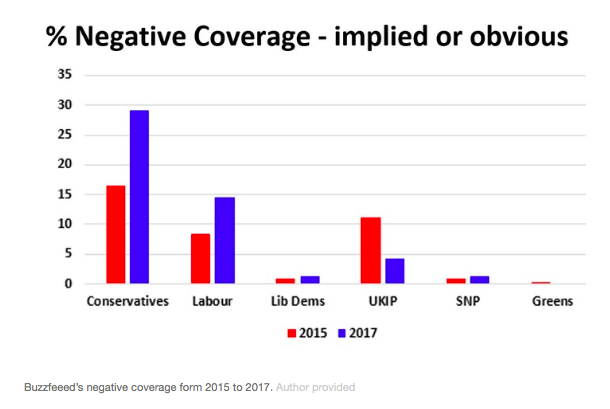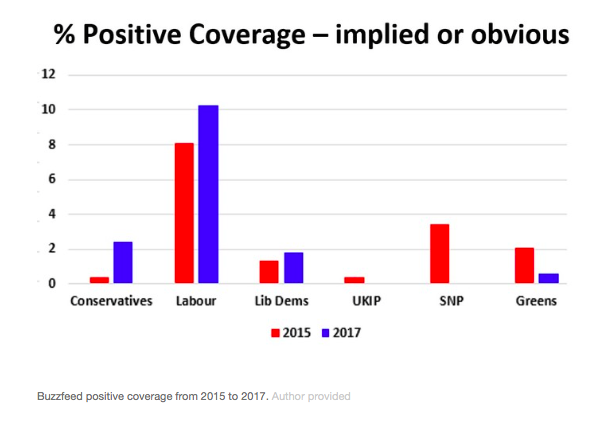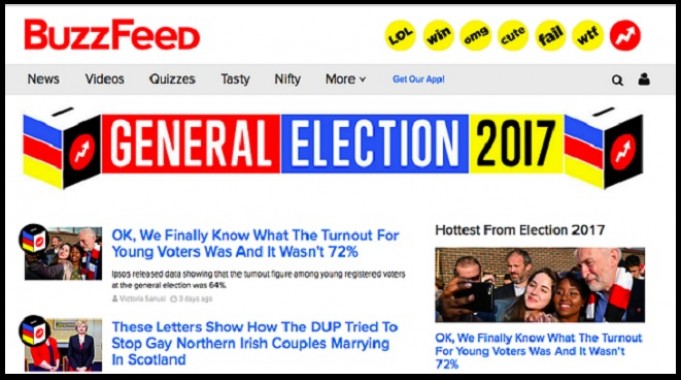Buzzfeed and the 2017 UK election
Reprinted from The Conversation
When it comes to explaining Jeremy Corbyn’s success at the British general election, much attention is paid to the rise of alt-left news sites such as The Canary and Evolve Politics. Some commentators have even concluded that the power of the right-wing press is over as young people increasingly turn to online and social media platforms for their news.
Buzzfeed’s Jim Waterson published a widely shared article: “This Was The Election Where The Newspapers Lost Their Monopoly On The Political News Agenda”, highlighting the reach of new alt-left blogs and their new role in the fast-changing media ecosystem.
But while new partisan blogs have been connected to Labour’s electoral success, the role of Buzzfeed itself – which began life little more than ten years ago – has received far less attention. There was for a while some debate about whether Buzzfeed was a tech company or a media organisation, but the brand has in recent years established itself as a major news destination, particularly for young people.
It now has a weekly reach similar to some of the largest online newspaper and broadcast platforms. And, while traditionally the battle over election night in the UK has been between BBC and ITV, Buzzfeed’s live coverage on Facebook attracted 2m viewers. According to the latest Reuters 2017 Digital News Report, Buzzfeed now has “strong political coverage aimed at millennials”.
But why did Buzzfeed became so popular, particularly with young people? According to Michael Massing (former editor of the the Columbia Journalism Review), Buzzfeed first became famous for “lightweight listicles … jaunty GIFs … teasing headlines, and, most of all, cute cats and dogs” and its advertisement for an “associate editor for animals” suggested a preference for reporting kittens in trees rather than politicians – like Theresa May – in kitten heels.
But over the past couple of years, Buzzfeed has been investing in serious journalism, recruiting more staff – and it is beginning to be recognised as a key player. In 2017, for example, it received a nomination for the Pulitzer Prize in international reporting and, in the UK, hired Politico’s Alex Spence and former Independent journalist Emily Dugan (who was shortlisted for the News Reporter of the Year award at the 2015 British Press Awards). It has also attracted senior editors, including Janine Gibson, Stuart Millar and James Ball, all previously at the Guardian.
Although Buzzfeed has retained its original quirkiness, its news agenda serves audiences often not regularly exposed to political information. As Susana Sampaio-Dias and James Dennis of Portsmouth University pointed out, Buzzfeed still used “quizzes, dank memes, and cute photos of dogs at polling stations” in coverage of the election, but now such elements can act “as an important entry point for younger citizens into a range of complex political stories”.
Changing style
As part of an ongoing research project, we examined Buzzfeed during the 2015 and 2017 general election campaigns and found the tone, style and agenda has changed markedly. In 2017, coverage was more serious and informative, with more investigative and agenda-setting articles. More than one in four election articles were light hearted in nature in 2015, whereas during the 2017 campaign just over 5% had a comedic tone.

In 2015, headlines such as “David Cameron Says He’s Learned ‘Frozen’ Off By Heart” and “This Woman Has Tattooed Alex Salmond’s Face On Her Leg” represented a large part of Buzzfeed’s agenda. But in 2017 the agenda became more policy-driven, including articles such as: “Labour Wants To Scrap Tuition Fees, Renationalise The Railways, And Give More Cash To The NHS” and “The Majority Of Tory MPs Will Still Be White And Male After The General Election”.
Overall, we found nearly three times more policy items in 2017 than 2015, with less emphasis on campaign process and the personalities of leaders.

However, in 2015 coverage of the parties was more diverse, prominently including articles about UKIP, the Greens and the SNP. In 2017 Buzzfeed focused on the two-horse race – Labour and the Conservatives – and the leadership battle between May and Corbyn. This follows the pattern of coverage in broadcast news and the press.

Partisan press
Broadcasters, of course, have to remain impartial, whereas the UK national press are well known for their partisan coverage. In both 2015 and 2017 general election campaigns, a Loughborough University study found Labour overwhelmingly received negative coverage from newspapers while coverage of the Conservatives was largely positive.

By contrast, we found Labour received far more positive coverage and less negative framing in Buzzfeed news during the 2017 election campaign.

Buzzfeed was not, however, averse to publishing articles critical of Labour. Take, for example “Here’s Diane Abbott’s Absolute Car Crash Of An Interview About Hiring More Police Officers” and “This Town Has Been Labour Since 1919. It’s About To Switch To The Tories”.
At the same time, articles such as “People Are Getting Fed Up With Theresa May’s Campaign Being So Stage-Managed” and “How The Tories’ Decision To Buy Google Ads About The ‘Dementia Tax’ Backfired” were negative stories unlikely to be reported by much of the national press who supported the Conservative Party.
While more sympathetic to Labour, Buzzfeed is not as one-sided as partisan blogs like Another Angry Voice. It adopts a more objective approach while remaining distinctive from the mainstream media. Over the last few years some of its journalists, including Emily Ashton and Waterson, have become established figures, reviewing newspapers on news channels and helping to set the Westminster agenda on programmes such as The Andrew Marr Show.
Given its expanding reach and more policy-driven agenda, it is now time Buzzfeed’s journalism was taken even more seriously.
Richard Thomas is Lecturer, School of Arts and Communication, Leeds Trinity University.
Stephen Cushion is Reader, School of Journalism, Media and Cultural Studies, Cardiff University







